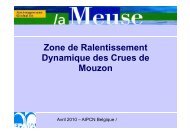PIANC E-Magazine - PIANC AIPCN welcome
PIANC E-Magazine - PIANC AIPCN welcome
PIANC E-Magazine - PIANC AIPCN welcome
Create successful ePaper yourself
Turn your PDF publications into a flip-book with our unique Google optimized e-Paper software.
4. EXAMPLE OF APPLICATION<br />
Figure 13 shows the application of the formulae in<br />
one laboratory test, which compares the results to<br />
those obtained with the formulae reviewed in the<br />
literature. The model consists of a cube armoured<br />
breakwater, high crown wall ( g ƒ<br />
= 0.26 m), water<br />
level (h = 0.55 m), Ir = 3, Hs = 0.16 m, Rc =<br />
0.2633 m, Ac = 0.19 m, g ƒ<br />
= 0.5 , Ba = 0.12 m, L 01<br />
= 3.396 m, Wc = 0.0033 m and Be = 0.3 m. The<br />
experimental forces calculated from the test pressure<br />
records were Fhexperimental = 257 N/m and<br />
Fvexperimental = 123 N/m.<br />
Replacing the data in formulae (4) and (5), the results<br />
are Fh = 290 N/m and Fv (Fh) = 122 N/m. In<br />
figure 13, a summary of all results obtained using<br />
the different authors’ formulae is shown. Formulae<br />
IV, V and VI were applied despite their not fulfilling<br />
all the application conditions, just to check if some<br />
additional information about the phenomenon<br />
could be deduced.<br />
The forces to compare are the same in all the<br />
cases, because for tests of 1,000 waves, Fh 0.1%<br />
=<br />
Fh max<br />
, being these values the ones estimated by<br />
all the authors. Estimated up-lift pressure value in<br />
all the cases is the one obtained by the pressure<br />
law continuity at the crown wall base.<br />
Formulae I, II and III show similar values, the formula<br />
developed in this investigation being the one<br />
that best fits the up-lift pressures.<br />
It should be taken into account that each formula<br />
(including the one developed in this paper) was<br />
designed for a given test and therefore present<br />
the intrinsic errors associated with an empirical<br />
method. All of them should be applied carefully<br />
considering the limitations in their application.<br />
5.CONCLUSIONS<br />
The formulae developed in this paper are easily<br />
applied, in comparison with the other existing<br />
formulae. The text below describes the logical<br />
process to calculate the crown wall using the proposed<br />
formulae:<br />
• From overtopping limitations, Ac and Rc are obtained.<br />
• Crown wall height (hƒ), base width (Be) and<br />
foundations level (Wc) are proposed.<br />
• With the previous values and wave characteristics<br />
at the breakwater toe, horizontal and uplift<br />
forces can be calculated using the formulae<br />
developed in this paper.<br />
Figure 13. Application of the different formulae to a given test<br />
39<br />
<strong>PIANC</strong> E-<strong>Magazine</strong> n° 144, November/novembre 2011




